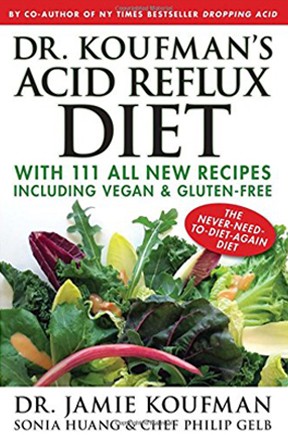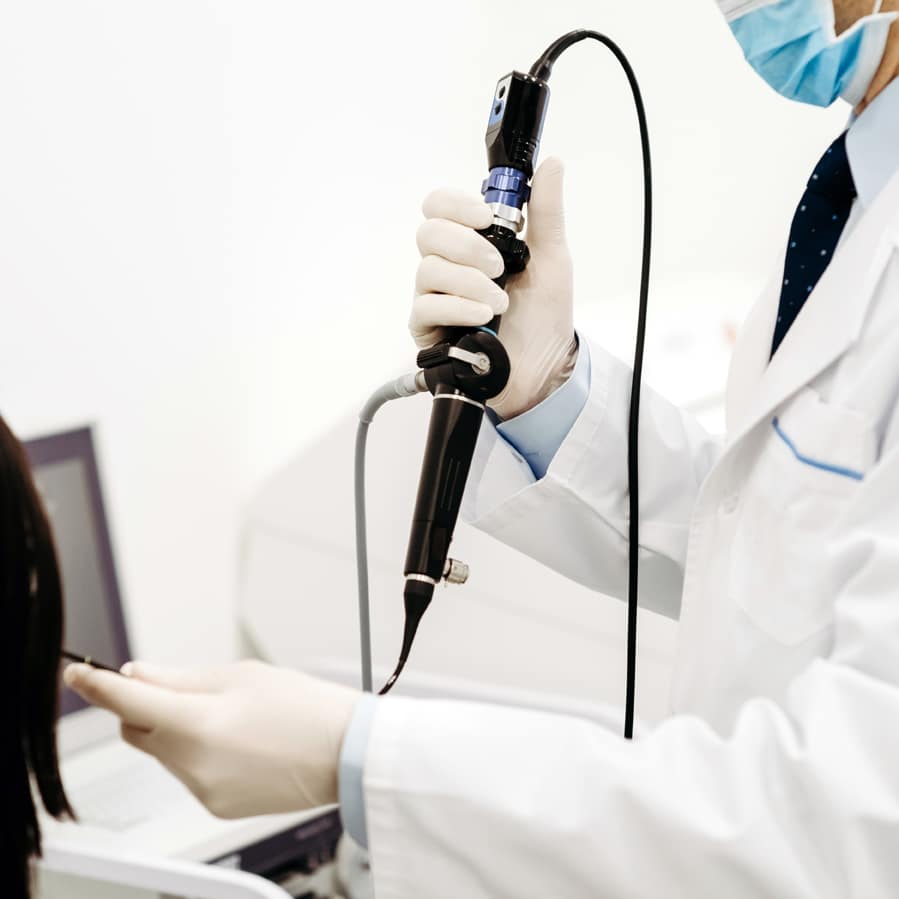
Test Your Knowledge – Take The Reflux Quiz
1. Derived from the Greek fluere, the word “reflux” means:A. Flute
B. Stomach pain
C. Throw
D. Backflow
E. Vomit
2. All of the following are common symptoms of acid reflux EXCEPT:A. Hoarseness
B. Heartburn
C. Choking
D. Hiccups
E. Cough
3. What is it that makes silent reflux silent?A. No burping
B. No coughing
C. No flatulence
D. No heartburn
E. No hoarseness
4. Laryngopharyngeal reflux (LPR) refers to gastric reflux into the:A. Throat
B. Esophagus
C. Duodenum
D. Eustachian tube
E. None of the above
5. Which of the following causes the tissue damage from reflux?A. Acid
B. Papain
C. Pepsin
D. Amylase
E. Acid & pepsin
6. Which of the following is NOT true of the pH scale used to measure acidity?A. pH 7 is neutral
B. pH 2 is very acidic
C. pH 6 is mildly acidic
D. pH 1 not seen in humans
E. pH 14 not seen in humans
7. All of the following foods are BAD for reflux EXCEPT:A. Banana
B. Vinegar
C. Soda pop
D. Orange juice
E. Chocolate
8. Which of these is GOOD for reflux?A. Pepper
B. Ginger
C. Garlic
D. Sugar
E. Salt
9. All of the following are true about reflux and meals EXCEPT:A. Late night snacking is really bad for reflux
B. Almost everyone refluxes some after most meals
C. More reflux occurs after dinner than any other time
D. High-fat meals cause more reflux than low-fat meals
E. It’s okay to recline after eating, but it’s not okay to sleep
10. For the serious refluxer, foods and beverages below which pH level should be avoided?A. pH 7
B. pH 6
C. pH 5
D. pH 4
E. pH 3
CORRECT ANSWERS
References = superscript numbers
1. D. Backflow 1Literally, “reflux” is re- back + fluere flow, i.e., “backflow”
2. D. Hiccups 1-4Heartburn and indigestion are considered the telltale symptoms of GERD (gastroesophageal reflux disease). Symptoms of LPR (laryngopharyngeal reflux) are postnasal drip, too much mucus, chronic throat clearing, a sensation of a lump in the throat, difficulty swallowing, sinus pressure, nasal congestion, hoarseness, choking episodes, asthma, shortness of breath, chronic cough5 … and that is not all of them. By the way, the newest and more intuitive term that should replace LPR is respiratory reflux, acid reflux into the respiratory tract.
3. D. No heartburn 1-4The main symptoms of GERD are heartburn and indigestion, and so people who do not have those symptoms are considered to have silent reflux.
4. A. Throat 2LPR literally means larynx-pharynx reflux, that is, reflux into the voice box and throat. The voice box is actually a part of the pharynx (throat); it is termed the laryngopharynx.
5. E. Acid & Pepsin 1,3,7-11Although it is called “acid reflux,” it is actually the main enzyme of the stomach, pepsin, that causes tissue inflammation and damage in the esophagus (GERD) and respiratory tract ( LPR). Once you have had reflux events, pepsin binds to your tissues and then waits for acid from any source to rev it up. Remember, acid activates pepsin. Research has shown pepsin is found in tissue wherever there is reflux-caused inflammation.1,7-11 Pepsin is also associated with laryngeal cancer and Barrett’s esophagus.8 If you have reflux, you need to stop it cold long enough to let the tissue heal, that is, to wash out the pernicious pepsin. That’s why we recommend a “reflux detox” program — eating/drinking nothing pH <5 —for 2-4 weeks.2-6
6. E. pH 14 not seen in humans 4pH 7 is neutral. Anything below pH 7 is acidic, and anything above pH 7 is basic or alkaline. Stomach acid is typically pH 1-5. By the way, almost all soft drinks are about pH 3, and that’s bad for the pepsin in waiting (for activation). Why are soft drinks so low pH? This goes back to a regulation made by the FDA 1n 1973, which mandated that everything in a bottle or can crossing state lines should be acidified to kill bacteria.3 Unfortunately, the FDA never said “don’t make your products too acidic” … but they all are. Indeed, soft drinks are the number one dietary cause of LPR.
7. A. Banana 3The pH of banana is almost pH 6. But even though it is considered a great fruit for refluxers, for approximately 5% of people banana is a reflux trigger food. Who knew?
8. B. Ginger 3Ginger, cinnamon, honey and most of the leafy spices such as parsley, cilantro, basil are all fine for refluxers, and ginger seems to help. Manuka honey, ginger and/or chamomile teas are all good for reflux.
9. E. It is NOT okay to recline after eating 4The number one causes of reflux in America is making the last meal of the day the big refueling meal, eating it too late, and lying down or going to bed too soon. In the old days, we recommended no eating or drinking within 3 hours of bed, but now, for the serious, especially the silent refluxer, it should be 5 hours for at least 2-4 weeks as part of a “reflux detox” program. For example, if you go to bed at 11p, try closing the kitchen at 6p for a few weeks.
10. C. pH 5 3,7-11The cell biology of reflux shows that acid and pepsin damage tissue within the respiratory tract at pH 5 or lower. That’s why in Dropping Acid: The Reflux Diet Cookbook & Cure, we recommend nothing acidic (pH <5) during the detox program, again for a minimum of 2-4 weeks. And by the way, we NEVER recommend apple cider vinegar or lemon juice for reflux.
References
- Koufman J. The otolaryngologic manifestations of gastroesophageal reflux disease (GERD): A clinical investigation of 225 patients using ambulatory 24-hour pH monitoring and an experimental investigation of the role of acid and pepsin in the development of laryngeal injury. Laryngoscope 101 (Suppl. 53):1-78, 1991
- Koufman J. Laryngopharyngeal reflux is different from classic gastroesophageal reflux disease. Ear Nose Throat J. 81:7-9 2002.
- Koufman J, Stern J, Bauer MM, Droppng Acid: The Reflux Diet Cookbook & Cure. Published by The Reflux Cookbooks LLC (Katalitix Media), New York and Minneapolis, September 16, 2010.
- Koufman J, Huang S, Gelb P. Dr. Koufman’s Acid Reflux Diet. Published by Katalitix Media, New York, December 29, 2016.
- Koufman J. The Chronic Cough Enigma. Published by Katalitix Media, New York, February 11, 2014.
- Koufman J. Low-Acid Diet for Recalcitrant Laryngopharyngeal Reflux: Therapeutic Benefits and Their Implications. Ann Otol Rhinol Laryngol 120:281-87, 2011.
- Axford SE, Sharp S, Ross PE, Pearson JP, Dettmar PW, Panetti M, Koufman J. Cell biology of laryngeal epithelial defenses in health and disease: Preliminary studies. Ann Otol Rhinol Laryngol 110:1099-1108, 2001.
- Johnston N, Bulmer D, Gill GA, Panetti M, Ross PE, Pearson JP, Pignatelli M, Axford A, Dettmar PW, Koufman J. Cell biology of laryngeal epithelial defenses in health and disease: Further studies. Ann Otol Rhinol Laryngol 112:481-491, 2003.
- Johnston N, Knight J, Dettmar PW, Lively MO, Koufman J. Pepsin and carbonic anhydrase isoenzyme III as diagnostic markers for laryngopharyngeal reflux disease. Laryngoscope 114:2129-34, 2004.
- Johnston N, Dettmar PW, Bishwokarma B, Lively MO, Koufman J. Activity/stability of human pepsin: Implications for reflux attributed laryngeal disease. Laryngoscope. 117:1036-9, 2007.
- Birchall MA, Bailey M, Gutowska-Owsiak D, Johnston N, Inman CF, Stokes CR, Postma G, Pazmary L, Koufman J, Phillips A, Rees LE. Immunologic response of the laryngeal mucosa to extraesophageal reflux. Ann Otol Rhinol Laryngol. 117:891-5, 2008.









